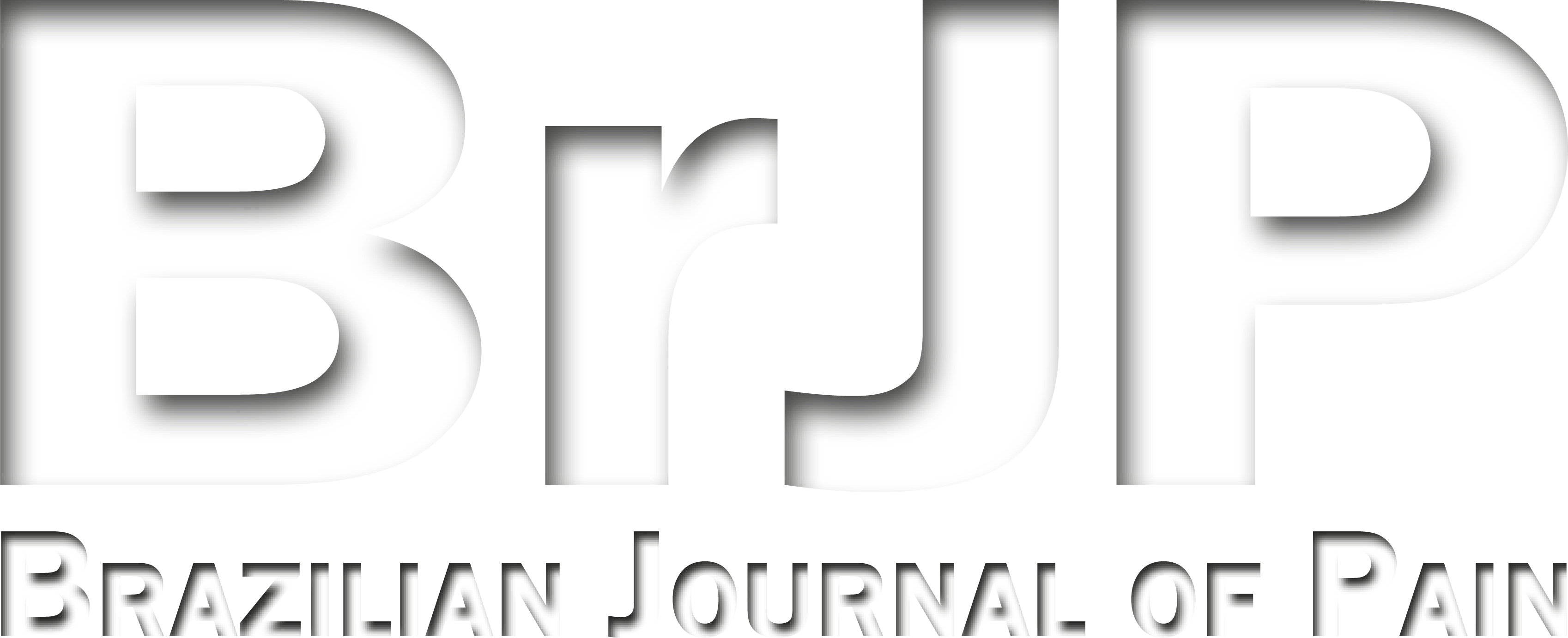The effect of biofeedback on pain and sleep in a patient with temporomandibular disorder. Case report
Efeito do biofeedback na dor e no sono de paciente com disfunção temporomandibular. Relato de caso
Kessia Fernandes; Antônio Sérgio Guimarães; Miguel Meira e Cruz
Abstract
Keywords
Resumo
Palavras-chave
References
De Leeuw R, Klasser GD. Orofacial Pain: Guidelines for assessment, diagnosis, and, and management. 2008.
Chisnoiu AM, Picos AM, Popa S, Chisnoiu PD, Lascu L, Picos A. Factors involved in the etiology of temporomandibular disorders-a literature review. Clujul Med. 2015;88(4):473.
Rikmasari R, Yubiliana G, Maulina T. Risk factors of orofacial pain: a population-based study in West Java Province, Indonesia. Open Dent J. 2017;29(11):710-7.
Lucena IM, Rodrigues LLFR, Teixeira ML, Pozza DH, Guimaraes AS. Prospective study of a group of pre-university students evaluating anxiety and depression relationships with temporomandibular disorders. J Clin Exper Dent. 2012;4(2):e102-6.
Rener-Sitar K, John MT, Pusalavidyasagar SS, Bandyopadhyay D, Schiffman EL. Sleep quality in temporomandibular disorder cases. Sleep Med. 2016;25:105-12.
Natu VP, Yap AU, Su MH, Irfan Ali NM, Ansari A. Temporomandibular disorder symptoms and their association with quality of life, Emotional states and sleep quality in South-East Asian youths. J Oral Rehabil. 2018;45(10):756-63.
Meira e Cruz M, Sousa B, De Laat A. Sleep and Orofacial Pain: Physiological Interactions and Clinical Management. Sleep Medicine in Clinical Neurology. 2019.
Cruz MM, Manetta I. Sleep and pain: a circadian multi-challenge rather than a simple bidirectional pathway. BrJP. 2019;2(3):303-4.
Meira E Cruz M, Lukic N, Wojczynska A, Steiger B, Guimarães AS, Ettlin D. Insomnia in patients seeking care at an orofacial pain unit. Frontiers Neurol. 2019;10:542.
Siepmann M, Aykac V, Unterdörfer J, Petrowski K, Mueck-Weymann M. A pilot study on the effects of heart rate variability biofeedback in patients with depression and in healthy subjects. Appl Psychophysiol Biofeedback. 2008;33(4):195-201.
Crider A, Glaros AG, Gevirtz RN. Efficacy of biofeedback-based treatments for temporomandibular disorders. Appl Psychophysiol Biofeedback. 2005;30(4):333-45.
Lovato N, Miller CB, Gordon CJ, Grunstein RR, Lack L. The efficacy of biofeedback for the treatment of insomnia: a critical review. Sleep Med. 2019;56:192-200.
Frank DL, Khorshid L, Kiffer JF, Moravec CS, McKee MG. Biofeedback in medicine: who, when, why and how?. Ment Health Fam Med. 2010;7(2):85-91.
Silva J, Padovani R, Viana M. O Emprego do biofeedback como estratégia de manejo do estresse e da ansiedade em atletas: um ensaio clínico. Rev Bras Terap Comport Cog. 2016;18(3):17-29.
Matsuoka H, Chiba I, Sakano Y, Toyofuku A, Abiko Y. Cognitive behavioral therapy for psychosomatic problems in dental settings. Bio Psycho Social Med. 2017;11:18.
Gatchel RJ, Stowell AW, Wildenstein L, Riggs R, Ellis 3rd E. Efficacy of an early intervention for patients with acute temporomandibular disorder-related pain A one-year outcome study. J Am Dent Assoc. 2006;137(3):339-47.
Criado L, de La Fuente A, Heredia M, Montero J, Albaladejo A, Criado JM. Electromyographic biofeedback training for reducing muscle pain and tension on masseter and temporal muscles: a pilot study. J Clin Exper Dent. 2016;8(5):e571-6.
Randhawa K, Bohay R, Côté P, van der Velde G, Sutton D, Wong JJ. The Effectiveness of Noninvasive Interventions for Temporomandibular Disorders: A Systematic Review by the Ontario Protocol for Traffic Injury Management (OPTIMa) Collaboration. Clin J Pain. 2016;32(3):260-78.
Gil-Martínez A, Paris-Alemany A, López-de-Uralde-Villanueva I, La Touche R. Management of pain in patients with temporomandibular disorder (TMD): challenges and solutions. J Pain Res. 2018;16(11):571-87.
Fujisawa M, Kanemura K, Tanabe N, Gohdo Y, Watanabe A, Iizuka T. Determination of daytime clenching events in subjects with and without self-reported clenching. J Oral Rehabil. 2013;40(10):731-6.
Sato M, Iizuka T, Watanabe A, Iwase N, Otsuka H, Terada N. Electromyogram biofeedback training for daytime clenching and its effect on sleep bruxism. J Oral Rehabil. 2015;42(2):83-9.
Bergamasco EC, Cruz DALM. Adaptação das visual analog sleep scales para língua portuguesa. Rev Latino-Am Enfermagem. 2007;15(5).
Bertolazi AN, Fagondes SC, Hoff LS, Dartora EG, Miozzo IC, de Barba ME. Validation of the Brazilian Portuguese version of the Pittsburgh Sleep Quality Index. Sleep Med. 2011;12(1):70-5.
de Barros Pascoal AL, de Freitas RFCP, da Silva LFG, Oliveira AGRC, Dos Santos Calderon P. Effectiveness of counseling on chronic pain management in patients with temporomandibular disorders. J Oral Facial Pain Headache. 2019;34(1):77-82.
de Resende CMBM, de Oliveira Medeiros FGL, de Figueiredo Rêgo CR, Bispo ASL, Barbosa GAS, de Almeida EO. Short-term effectiveness of conservative therapies in pain, quality of life, and sleep in patients with temporomandibular disorders: a randomized clinical trial. Cranio. 2019:1-9.
Florjanski W, Malysa A, Orzeszek S, Smardz J, Olchowy A, Paradowska-Stolarz A. Evaluation of biofeedback usefulness in masticatory muscle activity management - a systematic review. J Clin Med. 2019;8(6).
Gu W, Yang J, Zhang F, Yin X, Wei X, Wang C. Efficacy of biofeedback therapy via a mini wireless device on sleep bruxism contrasted with occlusal splint: a pilot study. J Biomed Res. 2015;29(2):160-8.
Jokubauskas L, Baltrušaitytė A. Efficacy of biofeedback therapy on sleep bruxism: a systematic review and meta‐analysis. J Oral Rehabil. 2018;45(6):485-95.
Watanabe A, Kanemura K, Tanabe N, Fujisawa M. Effect of electromyogram biofeedback on daytime clenching behavior in subjects with masticatory muscle pain. J Prosthodont Res. 2011;55(2):75-81.
Haggiag A, de Siqueira JTT. A new biofeedback approach for the control of masseter and temporal myalgia: utilization of an awake posterior interocclusal device. Cranio. 2020;38(3):180-6.
Sommer I, Lavigne G, Ettlin DA. Review of self-reported instruments that measure sleep dysfunction in patients suffering from temporomandibular disorders and/or orofacial pain. Sleep Med. 2014;16(1):27-38.
Kirchner LF, Buela-Casal G, Reis MJD. Terapia cognitivo-comportamental para dor e insônia em adultos: revisão de ensaios clínicos. Rev Bras Terap Comport Cognitiva. 2017;19(4):102-18.
Submitted date:
04/05/2020
Accepted date:
05/28/2020


